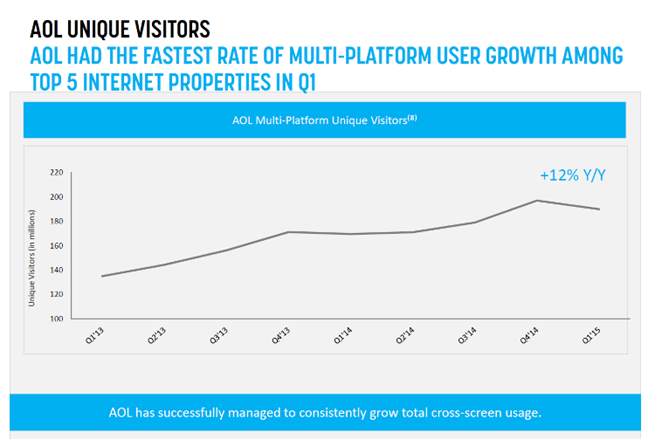This was a very active week in telecom, with AT&T extending its termination date on its DirecTV merger to the end of June; Charlie Ergen making headlines defending the designated entity structure for the latest wireless auction (CNBC interview here); Google releasing its self-driving car on California roads this summer (scary thought – RCR Wireless News article here); and the nomination of Sequans Communications (where I am a board member) for a Leading Lights award as the most innovative “Internet of Things” vendor for their Cat-1 chip solution.
Verizon bought AOL: It’s just a warm-up
The big headline came on Monday, however, when Verizon Communications announced its $4.4 billion offer for AOL. It’s very clear that it did not buy AOL for its Membership Services business (see AOL’s first quarter 2015 news release here – yes, there are still approximately 2 million dial-up customers on AOL paying $15 to $20 per month to access the Internet), but for the multiplatform ad services business. As we discussed in our analysis of Verizon’s first-quarter earnings, they are setting themselves up to be a mobile-first broadcaster.
Rather than dive into the intricacies of each of AOL’s platform businesses (which, with the exception of Member Services, are growing very nicely per the Q1 2015 report), let’s talk about how Verizon will make the most out of AOL. First, it will sell the news properties and reclaim at least $1 billion for the Huffington Post and TechCrunch brands. Second, it will extend LTE Internet – Installed (formerly known as HomeFusion, Verizon’s rural/hard-to-reach residential offering) to all of the AOL members and increase its wireless base by a few hundred thousand customers, which will come in handy during the historically weak third-quarter earnings season. Conservatively, this could generate another $300 million in service revenue growth – roughly $150 million to $170 million in earnings before interest, taxes, depreciation and amortization – for Verizon.
Excluding the ad platform business, at least $2 billion of the $4.4 billion purchase price can be justified. To be a successful wireless broadcaster, Verizon needs to better understand the profiles of its wireless user base; not who they call or text, but where they go on the Web and, most importantly, how they consume video. AOL has a terrific analytics/tracking platform for that.
Next, Verizon needs a way to associate ad inventory with user profiles – think car-related advertisements for folks who watch the Mecum Auto Auctions. And, once the ad has been placed in front of the Verizon Wireless subscriber – not only who clicked, but who watched and for how long – Verizon can now provide information on how to make advertisements more effective for its user base. All of these elements are critical to being an effective broadcaster and – if Verizon moves more aggressively into attracting original content – determining the value of a show series or episode.
There are a lot of skeptics in the telecom world who think Verizon will stumble and fall against Google and Facebook. Neither Google nor Facebook have networks like Verizon, however, which means that their success hinges on others’ ability to broadcast information on their behalf. In contrast, I think that Verizon is on the right path and just getting started. AOL is a warm-up act for something much larger, and this acquisition is a relatively low-risk way to figure out the next step.
Mobile first – what does it mean and why does it matter?
About a month ago, I asked you to describe the situations in which you reach for your mobile phone first to get information. After reading around 55 responses, the trend is unmistakable – we are turning to our mobile devices for more information each day.
Specifically, several areas came up as critical (I clarified with several of you the importance of having these functions on a mobile device and was told to a tee “I can’t live without these”):
1. Maps and navigation. According to the Census Bureau, about 35 million to 40 million of us move every year. As a result, we need to find our bearings – learn about our new neighborhood, community and region. Maps matter, and it’s why Google spends a lot of money getting Maps right. With new features in Google Maps (such as alternate routes), it’s one of if not the most taxing application (memory, power) on most smartphones. To many, the smartphone app has replaced Garmin, Tom-Tom and in-car navigation. To others, it’s a source of quick directions or a clarification. Without a doubt, we cannot live without a map app, and its high dependence on location makes it a perfect application for smartphones. (Note: Verizon picked up MapQuest with the AOL acquisition – wonder what they will do with that company?)
2. Travel. The app array grew a lot larger for travel as many well-known brands have built out their own applications. Airlines, rental cars, hotels and the buying aggregators (Expedia, others) dominated the feedback. Many of you appreciated (?) airline notifications and mobile boarding passes. Interestingly, several travelers noticed that support/help is strangely missing from many of these traveler provider sites – like a direct link to @SouthwestAir and @AmericanAir. Reaching customer support is very hard when you are pressed for time and need to use a mobile device to do the work of a computer. It’s time for the travel industry to step up to this challenge and figure out a better, more coordinated solution.
3. Weather. I am a big weather app person because I travel a lot (as most of you remind me of every time we meet). I never make a trip to Chicago, Denver, New York or Boston without checking first – especially in the spring. I thought I was a weather “power user” – you proved me wrong. I clarified with several of you who reported weather as an app you could not live without on your mobile: for most of you, it’s the first information you receive before you start your day. For (sports) families, it’s a big deal (especially this spring in Dallas). For Bostonians, instant access to weather apps was as means of survival during last winter’s snowstorms. There’s also a high correlation between weather and travel (airline app) usage. Interestingly, most of you said that you love your weather app more than the Internet version because the latter is so bad. Probably not what WeatherBug or Weather.com intended when they created their apps, but they should take the design considerations they used for mobile and transfer them to new and improved Web versions.
4. Reading/audio books. I have to admit, it’s not at the top of my list, but at least half of you would prefer to use your mobile device to read books than to access them over a computer. For about half of that group, the smartphone is the sole source of accessing Kindle information (note: before you quote this, we should get a larger sample size than 12 – I struggle to believe that even an iPhone 6 Plus is good enough for reading, but we did have more than a few 18- to 35-year-olds in the sample size). I was not able to get enough responses to confirm whether the Kindle is used as a complement to smartphone “passage snacks” – perhaps some of you can fill me in on your Kindle consumption habits. I am not surprised to see audio-book usage high given the ability to pair Bluetooth so easily with most cars. Amazon.com did a fantastic job on the Audible app – with more than 20 million downloads and over 100,000 4- or 5-star ratings on Google Play, it’s no surprise to see this part of Amazon’s business doing so well. In fact it begs the question: “Where would Audible be without mobile?” A good ice-breaker for the wee hours of your Memorial Day party.
5. (Financial) News. As far as categories go, news was a distant fifth. Financial news is a time-sensitive matter, however, and many of you cited your favorite stock quote site as the place where you get your news (and many of you also contrasted that with a cluttered and ad-laden website alternative). News organizations have slowly embraced the Web (the Drudge Report still does not have a mobile-friendly version), but times are changing. Notifications are getting better, and Yahoo has stepped up its use of excellent screen designs to report breaking news. Video-based news reporting is another matter, and one that several cited as an area for improvement.
Bottom line: Our society is increasingly becoming dependent on gathering information, receiving notifications and staying in touch through mobile devices. This is driving changes in how businesses look at mobile – not as an alternative or secondary design, but as the primary interface for getting information. If your business cannot fathom functioning through a four- or six-inch smartphone screen, it needs to start thinking.
A “mobile first” focus drives a lot of changes about how we look at the world:
1. It demands simplicity.
2. It forces efficiency.
3. It builds loyalty.
4. It solicits feedback.
5. It can create or destroy brands quickly.
Thank you for your detailed comments that helped us develop the Mobile First thesis. As we head into June, it’s the semi-annual handset/“It’s an Android World” issue.
Jim Patterson is CEO of Patterson Advisory Group, a tactical consulting and advisory services firm dedicated to the telecommunications industry. Previously, he was EVP – business development for Infotel Broadband Services Ltd., the 4G service provider for Reliance Industries Ltd. Patterson also co-founded Mobile Symmetry, an identity-focused applications platform for wireless broadband carriers that was acquired by Infotel in 2011. Prior to Mobile Symmetry, Patterson was president – wholesale services for Sprint and has a career that spans over 20 years in telecom and technology. Patterson welcomes your comments at [email protected] and you can follow him on Twitter @pattersonadvice. Also, check out more columns and insight from Jim Patterson at mysundaybrief.com.
Editor’s Note: The RCR Wireless News Reality Check section is where C-level executives and advisory firms from across the mobile industry share unique insights and experiences.




